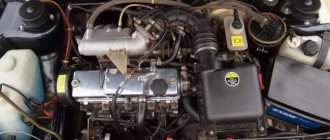Technical data VAZ 11183 1.6
- VAZ 11183 1.6 is a four-stroke gasoline engine, the four cylinders of which are arranged in one row.
- Power supply of the power unit, injection, distributed fuel injection.
- The cylinder block of the Lada Kalina internal combustion engine is made of especially durable cast iron. The gas distribution mechanism is single shaft, has 8 valves. The timing mechanism is driven by a toothed belt from the crankshaft pulley.
- The engine piston has a stroke less than the cylinder diameter of 75.6 mm and 82 mm, respectively. The compression ratio of the internal combustion engine is 9.6. The fuel used is AI 95. It is permissible to use AI 92, for which you need to change the ignition timing.
- Power VAZ 11183 1.6, at 5200 rpm min., 81 l., sec. Torque at 3000 rpm, min., 125 Nm.
- Environmental compliance standards: Euro 2, Euro 3.
Fuel consumption
Fuel consumption when driving around the city is 8.8 liters per 100 km, mileage. When driving on the highway 6.2 liters. Total consumption is 7.6 liters per 100 km, mileage.
Oil consumption
The permissible consumption of motor lubricant is 50 grams per 1 thousand km. Types of oil used: 5W40, 10W40, 5W30, 15W40. The volume of engine lubricant in the VAZ 11183 1.6 engine is 3.5 liters. When changing, fill in 3.2 liters. Manufacturers recommend changing the oil every 15 thousand km.
Resource
Engine operating life according to factory data is 150 thousand km. In reality, in the right hands, the VAZ 11183 1.6 can last up to 300,000 kilometers.
Updated prioromotor with index 21127
Togliatti decided to update the existing engine 21126 and add a little fire to it - now Kalina 2 with such a “heart” will have a power of 106 horsepower, with a maximum torque of 150 N*m. This was achieved by adding different intake modes - at low speeds the air passes through a long channel, at high speeds through a short one. The engine also has a new absolute pressure sensor and updated software.
True, as with everything, there are some disadvantages - when the timing belt breaks, the valves wrinkle and the connecting rod and piston group of parts suffers.
General design features of internal combustion engines
The VAZ 11183 1.6 engine is a modified version of the already well-known carburetor power unit VAZ 21083. Most of the design elements are borrowed from this model. The cast iron cylinder block also has four in-line cylinders. But the aluminum cylinder head is adapted for distributed fuel injection. It has an overhead camshaft. The valves are driven by fists through pushers. Hydraulic compensators are not provided on this engine model. Because of this, periodic adjustment of the valves is required. Which you can do yourself by selecting the required number of steel washers.
The 11183 1.6 engine block is very similar to the VAZ 21083 power unit block. The only thing that has changed is the height of the cylinder block. As a result of these changes, the stroke of the piston group increased. It became 75.6 mm, instead of the previous 71 mm. Accordingly, engine capacity increased from 1.5 liters to 1.6 liters.
Conclusion
The Lada Kalina engine has several options. Thus, numerous variants of power units were installed on vehicles, which were developed for other models produced by AvtoVAZ. The engine has a simple design and is quite easy to maintain and repair.
The choice of oil for the Kalina engine is a very sensitive issue, since it determines how long and efficiently the main unit of the car will work. Therefore, it is recommended to fill in the fluid recommended by the manufacturer.
Design features of the VAZ 11183 timing belt
The camshaft of the gas distribution mechanism is driven from the crankshaft pulley using a toothed belt. Belt tension, unfortunately for drivers, is manual and brings a lot of trouble. Therefore, the belt often has to be tightened manually. A very important and pleasant point for owners of such an internal combustion engine is that when the timing belt breaks, the pistons do not meet the valves. This is possible thanks to the special design of the pistons, which has a recess in the upper part.
Modifications of the internal combustion engine VAZ 11183 1.6
This engine underwent a major modernization in 2011. On the new model, the receiver has been enlarged, and the throttle valve has received an electronic control system. The type of throttle control is called E-gas. The new engine acquired its own VAZ 11183-50 index, and its power increased to 82 hp. What is also important is that the VAZ 11183-50 began to comply with European compliance standards Euro 4.
It should be noted that in parallel with the VAZ 11183 engine, the VAZ 21114 engine was produced. By and large, this is the same engine. Most systems, components and mechanisms are identical.
However there are some differences:
- in the power system of the VAZ 21114 engine they used a completely different generator 5132.3771 for 90 Amp hours;
- a new fastening method was used to mount the generator;
- To drive the generator, a new belt with a thickness of 882 millimeters was used. The mechanism for tensioning the belt has also been changed.
All other components, systems and mechanisms of the engine are completely the same, despite the fact that the motors were produced in different production shops.
Recommendations for servicing the Lada Kalina engine
The service life of any engine depends on proper maintenance from the very first days of operation; the VAZ 11183 1.6 engine is no exception to the rule.
The manufacturer recommends servicing this engine in the following order:
- During the first kilometers of driving, the entire car undergoes grinding in of parts, including the engine. The grinding-in period is called the running-in period. It lasts about 1.5 thousand kilometers. After it expires, you need to replace the engine lubricant and the oil filter element.
- The next stage of maintenance must be performed after a mileage of 10 thousand kilometers. The engine oil and oil filter must be replaced. Also, at this stage it is necessary to change the air filter, measure the compression in the cylinders and adjust the valves.
- After 20,000 kilometers, it is necessary to diagnose all mechanisms and systems of the internal combustion engine. Naturally, you need to change the engine oil, since it must be replaced every next 10,000 kilometers.
- After 30 thousand, you only need to change the engine lubricant and filter element
- After a mileage of 40 thousand km, many engine elements and parts must be replaced:
- replacing the air flow filter element;
- replacing the fuel filter element;
- replacing the timing belt and roller;
- replacing the alternator belt if necessary;
- replacing the pump at the slightest play in the fuel pump pulley;
- replacing the valve cover gasket;
- other parts requiring replacement;
- In addition to replacing parts, during this period of operation the valves should be adjusted and diagnostics of the internal combustion engine systems should be carried out.
Subsequent maintenance must be carried out in accordance with points 2 and 5. The exception is motor oil and filter. They need to be replaced every 10 thousand kilometers.
Oil change video
Tuning
Due to the small volume of the engine, there is no point in tuning it. Increasing the volume by boring the cylinders can lead to the appearance of cavities. It will be much more effective to replace the block with a Priorovsky one. Lightweight pistons are installed, produced by ATF. Together with the piston group, the connecting rods and liners are replaced. The camshafts are changed to sports ones, and the valve group is changed to a lightweight one.
Attachable units are also subject to replacement: generator and pump. Instead of rubber pipes of the cooling system, silicone ones are installed. Properly selected parts and high-quality replacement will allow, together with chip tuning, to increase engine power to 130-140 hp.
- Refinement of the cylinder head
Possible malfunctions of VAZ 11183 1.6
The VAZ 11183 engine is an improved version of the VAZ 21083. Most of the possible malfunctions for these engines are similar:
Flow sensor
For cars, a number of VAZ models, including Lada Kalina and Lada Granta, stopping the engine while driving is popular. Experienced drivers know that the culprit of the breakdown is the sensor responsible for mass fuel consumption. When replacing this sensor, the engine will start without problems.
Oil leaking
A popular problem is engine lubricant leaks. Oil can leak through the valve cover gasket, gaskets and seals. Sometimes a leak can be so critical that complex repairs cannot be avoided. Critical failures include oil leakage through the crankshaft seals.
Overheat
Overheating of the VAZ 11183 power unit occurs due to the thermostat. Unfortunately, the quality of domestic spare parts leaves much to be desired. A newly installed thermostat may not work. The motor may overheat, or on the contrary, it may not heat up.
Engine knock
Knocks in the power unit are a real problem for many VAZ cars. It is necessary to take into account the fact that the engine knocks when cold. If the engine has already warmed up and the valve clearances have been adjusted, the problem may be more serious. To determine the problem, you will need to diagnose the internal combustion engine.
ECU
The control electronics on the VAZ 11183 1.6 engine is one of the sore spots. Most drivers have encountered its replacement. There may be several reasons for this. For example: increased fuel consumption, the engine cannot develop full power, idle speed failure.
Engine tripping
If the engine starts to stall, you need to check the spark plugs. If the spark plugs are OK, then the ignition coil has failed. Very rarely a valve can burn out.
The revolutions are floating
If the engine speed fluctuates, then with a high probability it can be said that a dirty throttle valve is to blame. Often the cause may be a failed electronic sensor.
Crankshaft bearings
If, when accelerating, you can hear the sound of metal in the engine, then there is a high probability that the crankshaft liners are rattling. Further operation of the vehicle is not advisable until the problem is resolved. Otherwise, scuffs may form on the crankshaft journals.
As can be seen from everything described above, the VAZ 11183 power unit has many weak points and possible malfunctions. However, given the simplicity of the engine design, drivers fix most internal combustion engine problems themselves. Here, it must be said that spare parts for the VAZ 11183 are low in cost. Thanks to these circumstances, many domestic drivers fell in love with this engine. They consider it a reliable, easily repaired power unit.
Reliability, weaknesses, maintainability
Reliability
Despite the presence of serious weaknesses (more on this below), most car owners and car service technicians consider the VAZ-11186 a reliable and economical engine. According to their numerous reviews, the motor differs from its predecessors for the better.
For example, a lot of interesting things can be found in engine discussions on various forums. Thus, a car owner writes: “... the mileage is already 240,000. It doesn’t eat oil. Lew Shel 10W-40. The car works in a taxi for days.” His interlocutor Alexander expresses himself in the same tone: “... the mileage is 276,000, the engine runs powerfully and stably. True, there was a re-flashing, and one more time I changed the pump with a belt and a roller.”
The reliability of the internal combustion engine is clearly indicated by the excess of the service life. A lot of engines easily exceeded the mileage level of 200 thousand km and successfully approached 300 thousand. At the same time, no significant breakdowns were observed in the engines.
The reason for the increased service life lies in timely engine maintenance, the use of high-quality fuels and lubricants and a careful driving style.
Easy starting of the internal combustion engine in severe frosts is noted, which is a good indicator for the Russian climate.
Additionally, it should be noted that the engine has a good safety margin, allowing tuning to double the power. This indicator clearly indicates the reliability of the motor.
Weak spots
Car owners note several weak points of the engine. Their occurrence is provoked by both car enthusiasts and factory defects.
A lot of troubles are caused by the water pump (pump) and the timing belt tensioner pulley. These two nodes have a low operating life. As a rule, their failure leads to a break or shearing of the timing belt teeth.
Further events develop according to the classical scheme: valve bending - engine overhaul. Fortunately, after the modernization of the CPG in July 2018, the valves remain intact when the belt breaks, and the engine simply stalls.
The next common malfunction is knocking noises in the unit when operating at idle speed. Most often they are caused by unadjusted thermal valve clearances. But both pistons and liners of the crankshaft main or connecting rod journals can knock. The exact address of the fault can be identified by engine diagnostics at a specialized service station.
The motor electrician is often concerned. Complaints are caused by low-quality sensors, a high-voltage coil (ignition unit) and an unfinished Itelma ECU. Electrical faults are characterized by floating idle speed and engine tripping. In addition, the engine sometimes simply stalls while driving.
VAZ-11186 is prone to overheating. The culprit is a thermostat that is not highly reliable.
Oil leakage is quite common, especially from under the valve covers. In this case, you should tighten the cover fastening or replace its gasket.











